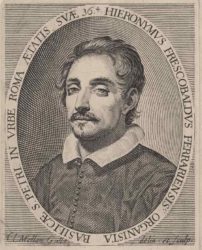13.1 With the publication of the Toccate e Partite d’intavolatura di cimbalo … Libro Primo, his first printed collection of toccatas, variations, and dances, Frescobaldi marked out the other half of his province as a keyboard composer. His previous works, although intended for the keyboard, grew out of the contrapuntal tradition of abstract part-writing made manifest in a partitura format. The traditional concentration on motivic development dominated both form and context. Figuration was essentially motivic in origin; structural articulations—whether unstressed as in the fantasia, elided as in the ricercar, or emphasized as in the canzona—were defined by successive stages in thematic manipulation.
13.2 Unlike the Fantasie and Recercari, printed from movable type, the Toccate was more elegantly (and expensively) engraved on copper. The first edition (1615) was prefaced by the dedication to Ferdinando Gonzaga, dated 22 December 1614, and an address “Al Lettore”; the volume contained twelve toccatas and variations on the Ruggero, Romanesca, and La Monica. In the second edition, whose expanded preface was dated 1616, some details of the toccatas were changed, the variation-sets were re-written, and variations on the Folia and four correnti were added. Three other editions appeared: one undated, one dated 1628 with a new titlepage, and the 1637 re-edition with its important Aggiunta of new works (See III. Prefatory Material, 3a-b, 4.).[1]
13.3 The historical development and compositional problems of the toccata, harmonic bass variation, and dance were in many respects diametrically opposed to those of the contrapuntal tradition. To begin with, they had developed as the province of the performer/improviser rather than the skilled contrapuntist. Their parameters of composition were not horizontal motives defining vertical structures but harmonic armatures—given in the variation and in some dances, contrived in the toccata—expressed by chords and by figuration in which motivic development played a secondary role.[2] This freedom of texture and part-writing was mirrored in the more flexible two-staff intavolatura di cimbalo, and dances and works based on secular materials were usually performed on the harpsichord. Both facts are reflected in Frescobaldi’s choice of intavolatura rather than partitura for the Toccate and its designation as di cimbalo.
13.4 Frescobaldi’s immediate point of departure for the most important of these genres was the Venetian toccata, as exemplified in Andrea Gabrieli’s toccatas published posthumously in his 1593 Intonazioni. These consist of an opening in chords and scales alternating between the hands; such passaggi in eighths or sixteenths were sometimes relieved by a central section in undecorated contrapuntal texture. Although Gabrieli’s toccatas contain in embryo all the elements of Frescobaldi’s, their general impression is one of ill-defined structure and mechanical figuration. The abbreviated Venetian-style toccatas published the same year in Il Transilvano lack even the textural contrasts of Andrea’s toccatas, but the two works contributed by Luzzaschi and Paolo Quagliati (ca. 1555-1628) are of interest as showing how the genre was treated by Frescobaldi’s teacher and by an illustrious Roman contemporary. Both toccatas display a more idiomatic keyboard style, marked in Luzzaschi by impressionistic part-writing and shifts of range and in Quagliati by imaginative short imitative figures, sequences, and a passo doppio (simultaneous figuration in both hands).
13.5 It remained for another Venetian, Claudio Merulo (1533-1604), to reveal the latent possibilities of the toccata in his two collections of 1598 and 1604 (posthumous), an imposing cycle of nineteen works grouped in ten modes. Merulo’s toccatas retain the external features of the Venetian toccata—chordal openings, figurally decorated harmonic successions, and contrasting contrapuntal sections—but they are constructed on a grander scale and infused with a new richness and expressiveness. This is particularly apparent in the treatment of figuration, which replaces the mechanical scales of the Gabrieli toccatas with material that is varied and unpredictable both in itself and in the changing textures that it creates. This greater freedom of texture is also apparent in the presence of contrapuntal passages not only as separate (and in fact detachable) sections but also as passing inflections of a figural texture. Merulo’s expressive and sophisticated figuration, the increased subtlety of his textures, and his refinement of the conventions of the Venetian toccata raised the genre to a level where, for the first time, it was capable of revealing the full range of a composer’s art.
13.6 This was not the case with the toccatas published by Trabaci and Mayone in 1603 and by Mayone in 1609, which have, in Willi Apel’s apt image, the air of plants grown in alien soil. For the most part they follow the general outlines of the Venetian toccata, with contrasting contrapuntal sections placed toward the end of the movement as well as in the middle, but their figuration is willfully erratic in design and sometimes repetitious (as well as occasionally unplayable, perhaps as a result of the Neapolitan partitura format). In Mayone’s toccatas, however, the figuration sometimes achieves a compelling sequential logic:
Ex. 13.1: Mayone 1609, Toccata prima, mm. 11-21

13.7 The toccatas of Trabaci and Mayone present a few original features later taken over by Frescobaldi. The Toccata seconda of Trabaci’s 1603 collection contains a section in triple meter, a feature absent from Venetian toccatas, and many of his and Mayone’s toccatas employ triplet figuration. Mayone’s toccatas often rein in the motion after a cadence by a shift to half-note chords, chromatically inflected with suspensions.[3] Nonetheless, though Frescobaldi may have borrowed these devices from the Neapolitans, his real forerunner was Merulo.
13.8 Six years after the appearance of Mayone’s second collection, Frescobaldi’s Toccate revealed a new world of brilliant, idiomatic, and sometimes disconcerting figured keyboard writing. The seventeenth-century performer may have been as dazzled by these works as we are, since Girolamo felt obliged to preface the first edition with a short guide to their performance and to enlarge and revise these directions for the second edition: “… may the affection please, with which I expound it [the manner of these compositions of mine] to studious practice, being sure that by means of this the works will be found more easy than they appear to be.”[4]
13.9 In the second version of his preface Frescobaldi characterizes the Toccate as embodying “the manner of playing with songlike affetti and diversity of passages” (“la maniera di sonare con affetti cantabili e con diversita, di passi”), terms whose meaning is elucidated obliquely in his two prefaces. In its narrow sense, “passi” denotes passages in consistent figuration such as eighths, sixteenths, and passi doppi for both hands; passi may have the character of passaggi, ornamental passage-work. More generally, passi are the main structural divisions of the toccatas, marked off by a half-note chord in both hands (presumably on the tonic, as the preface to the Capricci of 1624 suggests) and sufficiently complete for the performer to end the piece there.[5] The structural areas of the toccatas, passi, to which Frescobaldi refers in his prefaces are the opening in arpeggiated chordal texture; the continuation, which consists of smaller passi forming self-sufficient units; internal “suspensions, or dissonances” (“ligature, ò vero durezze”); and cadences.
13.10 To understand Frescobaldi’s “manner of playing with affetti cantabili” we need to look at the more general use of affetto. In A World of Words (1611 revision) John Florio defined affetto as “an effect, a motive, a disposition, a passion, a love or good will unto.” The Vocabulario degl’ Accademici della Crusca (Venice: Alberti, 1612) specified: “Affetto: a passion of the soul, born of the desire of the good, and of hatred of the evil” (“Affetto: passion d’animo, nata dal disiderio del bene, e dall’odio del male”).
13.11 In his preface to Le nuove musiche, 1602, Giulio Caccini understood affetto in the sense of the Vocabulario, as “a passion of the soul.” The passion or emotion was formulated verbally, to be realised in music: affetto is “nothing other than an expression of the words and of the idea that are undertaken to be sung, by the power of various notes and various accents, with the tempering of soft and loud, able to move delight in the listener.”[6] Caccini amplified this in his 1614 Nuove musiche e nuova maniera di scriverle: “the variety of the affetto is that passage which is made from one affetto to another with the same means, according to which the words and the conceit guide the singer successively.”[7] “Into which eloquence I would assimilate to the figures [of speech] and rhetorical ornaments, the passaggi, the trills, and other similar ornaments, which may sometimes be introduced sparingly into every affetto.”[8] In his Cartella musicale (1614) Adriano Banchieri described “… imitating with the harmony the emotions [affetti] of speech, so that in singing delight should be had not only by the composer himself, but equally [by] the singers and the listeners.”[9] The Bentivoglio lutenist Alessandro Piccinini used the word to mean something like “expression”: “in many places it must be sung with affetto.”
13.12 Sometimes affetto was used in the narrower sense of “ornament,” as when Ottavio Durante (1608) speaks of “passaggi and other affetti.” Durante 1608: “At the beginning of any affetuoso and serious composition whatever one must begin with gravity without passaggi but not without affetti” (“Nel principio di qualsivoglia composizione affettuosa, e grave si deve principiare con gravità senza passaggi ma non senza affetti”). Frescobaldi 1616 advises that variations with “passaggi, and affetti” demand a slower basic tempo than unadorned textures. Paolo Quagliati recommended that his Madrigali I à 4 of 1608 be performed “with an alternating measure, now broad and now quick, to give time and convenience to the graceful singers to ornament them with those graces & affetti that this music requires.”[10]
13.13 Quagliati’s counsel of madrigal-like flexibility of tempo is echoed by Frescobaldi in the 1616 advice to the reader, but with a changed meaning of affetti: “First: that this manner of playing must not remain subject to a beat, as we see practiced in modern Madrigals, which although difficult are facilitated by means of the beat taking it now slowly, now rapidly, and even suspending it in the air, according to their affetti, or meaning of the words” (emphasis mine).[11]
13.14 For Frescobaldi affetto signified the essential expressive meaning of a passo: “in those things that would not seem governed by contrapuntal practice, one must first seek the affetto of that passage & the purpose of the Author for the delight of the ear and the manner that it is sought in playing … But one must not however judge their difficulty before putting them well in practice on the instrument [=harpsichord] where with study one will know the affetto that it must have” (1624). The affetti are not, however, simple instrumental equivalences to verbal expression. Rather, Frescobaldi created a parallel world of affetti, of gesture and rhetoric conceived in specifically musical terms, in which his characters declaim in a manner at once unequivocal and untranslatable.
13.15 Alessandro Piccinini’s account of Neapolitan lute playing emphasizes the connection between affetti, dissonance, and free interpretation:
… and where the music is full of dissonances, for the sake of variety it succeeds very well sometimes to play as they do in Naples, where they restrike the same dissonance several times, now soft, & now loud, and the more dissonant it is, the more they restrike it, but in truth this [manner of] playing succeeds better in practice than in words, and particularly for those who relish affettuoso playing.[12]
13.16 The musical characteristics of affetto passages have been summarised thus: “For composers of ensemble music, ‘affetto’ was applied in a specific sense to moments of harmonic intensity in slow, chordal sections, with chromaticism, cross-relations, dissonances and unusual melodic movement [and frequently dramatic shifts of range].”[13] The affetti cantabili and diversità di passi of the toccatas thus describe works in large sections built up of contrasting units whose articulations and contrasts are further emphasized in performance. The aesthetic that governs them is dramatic in intent and vocal in expression.
13.17 Effetto, on the other hand, meant in general “that which received the being of the cause.” In musical terms, it might be translated as “special effects”: ornaments, such as “trilli, e gruppi, & altri nuovi affetti,” and various passaggi, whose performance often involved rhythmic alteration of the printed text. Frescobaldi 1615. 3b: “the last note of a trill, and of other effetti,” “taking them [the passi] more or less strictly according to the difference of their effetti.” Parallel passages in Frescobaldi’s two prefaces regarding flexibility of tempo in the toccata link the effetto with the affetto, a state of feeling like “their affetti, or [the] sense of the words… as we see used in modern Madrigals.”[14]
13.18 The ideal of affetti cantabili completes the transformation of figural material from ornamental to affective begun by Merulo. In Frescobaldi’s toccatas even the most conventional figuration is treated expressively. For example, when set against a passaggio, the measured trill is to be played not as written but rather as fast as possible, and the passaggio is to be performed affettuoso, expressively. The written-out trill with termination, little more than an annoying mannerism in the works of Andrea Gabrieli, is fused by Frescobaldi with two vocal ornaments, Cavalieri’s zimbalo and trillo (and possibly extra beats), and acquires the potential energy of a coiled spring to set a static texture in motion:
Ex. 13.2: Frescobaldi, Romancesca (1616), Dudecima [sic] parte, m. 1

13.19 In more extended linear figurations, the passaggi of earlier composers, Frescobaldi goes far beyond the alternations of scales and chords between the hands that were a staple of Merulo’s toccatas. Even where the alternation is fairly regular, the pacing has a new urgency. Within a single passo the figuration may range from relaxed scales to lines of melodic convolution and rhythmic complexity, often raised to a higher power by passi doppi of unprecedented rhythmic canons, cross-accents, and bold sweeps through the instrument:
Example 13.3: mm 17-22

13.20 Frescobaldi’s sensitivity to range and color is an important element in this new figural style. The range of an entire toccata is often laid out in the opening section, and its extremes function as barriers that are reached with a sense of real physical effort; when they are shattered, as in Toccata VI (compare mm. 8, 11, 13-14 with 34-35) it is a musical event of calculated brutality:
Ex. 13.4: Toccata VI, mm 5-10

mm. 32-39

13.21 This same sensitivity governs Frescobaldi’s deliberately ambiguous part-writing and his bold use of octave transposition, which translate the contrapuntal logic of the Fantasie and Recercari into a kind of fourth dimension. Changes of voice may be presented to the ear in unbroken lines (a device found in earlier Venetian and Neapolitan works), or a single line may suddenly split into two voices. Resolutions are transferred from one voice to another or doubled in octaves, and harmonic and melodic events are underscored by dramatic shifts of register which, at their most extreme, can transform melodic and even rhythmic sequences (cf. Toccata V, mm. 33-34).
13.22 The “diversità di passi” in the toccatas is expressed as a constant variety of musical texture, the product of variations in regularity of figuration, rate of harmonic change, the shape and contrapuntal density of imitative material, and chromaticism. The short conventional rhythmic patterns that recur throughout the collection—anapests, dactyls, dotted and Lombard rhythms—are primary materials for imitative textures: not the isolated passages that appear in the toccatas of Andrea Gabrieli and Merulo (and here, in Toccatas VIII and IX) but imitations woven into the musical fabric. At the openings of the toccatas such imitations lighten the chordal structures, flickering from voice to voice (another device that Frescobaldi could have found in the toccatas of Merulo). In the course of the movement they check or impel forward motion with a subtlety unknown to Frescobaldi’s predecessors, and the ebb and flow of intensity in the passi is a product of the relative saturation of the texture with these motives and the consequent complexity of their accents. The cadences of the large sections are frequently set off by changes in texture, an intensification of short motives, a relaxation into more extended and regular passaggi, or—particularly at final cadences—a passo doppio: Frescobaldi directs that where there is a trill in one hand against a passage [the trill] must be taken rapidly and the passage slower and expressively. No matter what their notation cadences must be very sustained, “drawing out the tempo more slowly” (cf. Toccata I, mm. 25-27; III, mm. 20-25; V, mm. 22-25; IX, mm. 38-42).
Ex. 13.5: Toccata I, mm. 32-40

13.23 After these full cadences of passi Frescobaldi often employs one of two devices. The first, which he seems to have adopted from the Neapolitans or from the lute works of Kapsberger, consists of dissonant suspensions in half-notes: “also in the midst of the work [suspensions or dissonances] will be struck together, so as not to leave the Instrument [=Harpsichord] empty: which striking is repeated at the pleasure of the player” (1616) as in Neapolitan lute style (I, m. 13; II, m. 23; X, mm. 18-19, XI, mm. 37-38). The second method of creating a dramatic change in texture and character after a cadence is derived from Merulo and consists of an abrupt redistribution of parts into solo voice and accompaniment, the solo rising in range and usually anticipating the entrance of the accompaniment—the most obviously cantabile of Frescobaldi’s affetti
Ex. 13.6: a) Toccata X, mm 15-28

b) Toccata VI, m. 9-14

13.24 All these changing figurations and textures are firmly anchored in chords that are rarely stated as baldly as those implied by the bass, even in figured passages. Although Frescobaldi’s toccatas follow the modal arrangement of Merulo’s collections and Girolamo’s own Fantasie and Recercari, their harmonic structures are neither clearly modal nor clearly tonal.[15] The strongest harmonic relationships are fourth- and fifth-related progressions in root position, colored by step-related chords or others inverted to produce stepwise motion in the bass. These progressions frequently create smaller parenthetical events within a large harmonic context (e.g., Toccata IV, mm. 1-7). The minim cadences of the large passi occur on the tonic or some related degree. (In general, Frescobaldi’s harmonic thinking throughout his career shows less interest in varied tonal structures than many of his contemporaries: as late as the Bergamasca in the Fiori musicali of 1635, five of the seven full cadences occur on the tonic, the other two on the dominant.) In the progressions that govern the toccatas, major and minor thirds on the same scale-degree are interchangeable, and the Neapolitan device of flattening a previously major third is a frequent melodic inflection.
13.25 The pivotal sections in “suspensions, or dissonances” are only one example of the chromaticism—presumably Neapolitan-influenced—that marks the first book of Toccate. Toccata XII is in fact an essay in the Neapolitan toccata di durezze e ligature without passaggi, handled with a surer sense of form and harmonic direction than that of its predecessors. As early as the Fantasie Frescobaldi had learned the directional and organizing power of the chromatic line. This device became the thread linking the harmonies of his chromatic works, often operating almost subliminally through octave-transpositions and changes of voice:
Ex. 13.7: Toccata XII, mm. 1-25

13.26 All of these elements—chordal structures in a personal harmonic and chromatic idiom, expressive figuration, variety of texture, large sectional organization—combine to produce some general idea of the Frescobaldian toccata. An examination of Toccata I will suggest how they interact in context.
13.27 The passi that make up the work are defined by minim chords: section I, mm. 1-13, moving from g to D; section II, 13-16, D-G; section III, 16-27, G-D; section IV, 27-30, D-A; V, 30-40, d-G. The first two measures function as the opening, the quasi-improvisatory section that states a pure tonic note or chord and moves gradually to harmonic and rhythmic exploitation. Here the chordal texture is lightened by imitative anapest figures and lays out a number of harmonic and melodic alternatives even before leaving the G Dorian tonic. The movement to the dominant, characteristically accomplished by a stepwise and chromatically inflected intermediary, is accompanied by a loosening of the opening figuration into scale passages, and the establishment of V as a secondary tonic is coordinated with the establishment of the soprano A as the upper limit of the range, which is confirmed by a sweep through the range of the toccata (Ex. 13.3), … changes of voice (Toccata XII, mm. 5-9).
13.28 After the deceptive cadence on A as V of D, Frescobaldi explores the flat side of the mode prepared in the inflections of the opening two measures, again by fourth- and fifth-related chords and stepwise transitions. In m. 13 the cadence on D is reinterpreted as the dominant of the opening g (thus closing the harmonic parenthesis), and an ever tighter imitative texture pushes toward the final cadence of the passo (Ex. 13.4).
Ex. 13.8: Toccata I, mm. 1-12, 13-16

13.29 The third section consists of two contrasting passi. The first passo begins with long garlands of scales that gradually contract into a passo doppio ending in a deceptive cadence (mm. 16-21). The second passo opens with two motives in imitation dissolving into passaggi and cadencing on D (mm. 21-27). This D-g ambiguity is reinforced by an affetto cantabile (mm. 27-30) that momentarily checks the forward motion of the texture to prepare the final section (mm. 30-40), an unbroken succession of harmonies stating both the flat and sharp sides of the tonic expressed in constant short imitations that broaden into rising vocal lines and a final brilliant passo doppio:
Ex. 13.9: Toccata I, mm. 13-40


13.30 The variations in the Toccate e partite may be divided into “large” and “small” sets. In the extensive variations on the Ruggiero (eight) and the Romanesca (twelve) each partita unfolds freely and continuously without internal repetition. In the smaller variations on the Aria di Monica (six) and the six Partite sopra Folia added to the second edition both sets retain the structural repetitions of their originals (AAB in the Monica, AABB in the Folia). All of these subjects except the Monica had been employed by Neapolitan composers.
13.31 The Romanesca appears as “Romanesca I, o Guardame las vacas” in Alfono Mudarra’s Tres libros de música en cifra para vihuela (Seville: Léon, 1546), consisting of the melody “Guardame las vacas” over a simple harmonic progression which appears as the ground for the Recercada settima in the Trattado de Glosas (Rome: Dorico, 1553) of the Spanish-Neapolitan Diego Ortiz.
Ex. 13.10a: Original form of Romanesca (harmonic outline).
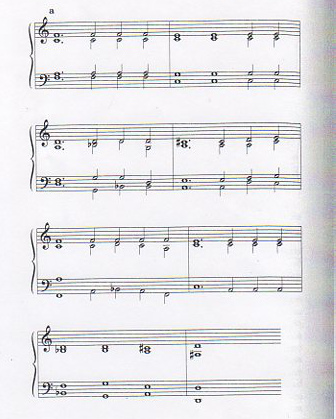
13.32 In this shape it functions as the bass of Antonio de Cabezón’s variations on “Guardame la vacas,” published posthumously in his Obras de musica para tecla, arpa e vihuela (Madrid, 1578). One of the first two printed volumes of Neapolitan keyboard music, the Intavolatura de cimbalo (Naples, 1576) of Antonio Valente (organist of S. Nilo, Naples) contains La Romanesca con cinque mutanze. By 1589 the French dance theorist Thoinot Arbeau could describe a Romanesca galliard as “hackneyed and trite” in his Orchésographie.[16] (A set of rigid ostinato variations on the bass in the Dublin virginal manuscript [ca. 1570] seems unrelated to the Mediterranean tradition.)
13.33 The Romanesca was recast—apparently by the the Neapolitans—in an extended form which not only prolonged its life for another quarter-century but which also illustrates a difference between sixteenth- and seventeenth-century sensibilities. Where Ortiz, Cabezón, and Valente had followed a bass that merely underlay a clear succession of chords, later Neapolitans created a line in which the original nodal points were bridged by melodic passing-tones, each of which in turn became a potential basis for figuration (Ex. 13.10):
Ex. 13.10b: The seventeenth-century Romanesca
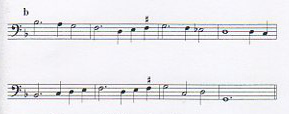
13.34 The turning point in this evolution seems to be the “Partite sopra la Romanesca de Stella,” which opens the manuscript London, British Library, Mss. Add. 30491. Scipione Stella, a Neapolitan musician of Gesualdo’s suite in Ferrara, presents the new extended pattern in four statements, with the pattern for the most part clearly audible in the bass. There are no passaggi and the surface ornamentation does not go beyond a quartering of the basic half-note beat. As in later versions of the Romanesca, the duple barring (2/2) masks an underlying triple organization (2/2+ 2/2+ 2/2).
13.35 The next Romanesca sets are those attributed to Ercole Pasquini in the manuscript Ravenna, Biblioteca comunale Classense, MS Classense 595 (thirteen parti), and those published in the Secondo libro di diversi capricci per sonare of Ascanio Mayone (d. 1627: Naples: Gargano and Nucci, 1609, seventeen partite). It is impossible to determine which set is the earlier, since Pasquini was active at least until 1608, and Silbiger concludes that the Ravenna manuscript was compiled “at the earliest during the years 1630-1640” (Silbiger 1989, 12 [1987], viii, his italics). Pasquini may have encountered the work of Stella during the latter’s service with Gesualdo in Ferrara.
13.36 Pasquini’s impressive setting employs the extended Romanesca bass plus a IV-V-I ripresa. Metrically the piece is organized in 3/2 with frequent hemiola (3 x 3 = 2 x 2 x 2). The figural writing is highly sophisticated, showing none of the mechanical right- left-hand alternation characteristic of earlier settings. The virtuosic writing extends up to c3 in the right hand and down to CC in the left. In some variations the figuration is consistent throughout while in others it changes at the second phrase of the bass. Devices such as a slithering rhythmic passage (sesta parte) and an unexpected homophonic setting (parte 12) recur in Frescobaldi’s variations.
13.37 For Ascanio Mayone the Romanesca was “il tenore antico.” His set of twenty partite employs the extended form of the bass organized into six-beat measures without a ripresa. Mayone attains a certain degree of motivic consistency through the repeated use of rising or falling thirds or fourths (partite 1, 2, 3 4, 5, 7, 10, 13, 14, 16, 18). Partita 6 presents a completely chordal texture, while partita 12 lightly decorates the same structure. The right hand extends to the top of the instrument, d3, while the left descends to CC. Mayone tends to carry out his figuration more consistently and logically throughout an entire partita than Pasquini.
13.38 In the seventeenth century the Romanesca also became the basis for numerous improvised and semi-improvised vocal compositions; the process of the transition from the instrumental to the vocal idiom seems unclear. Suzanne Cusick has nicely likened the Romanesca in this incarnetion to the classic twelve-bar blues: an aria “that improvising musicians used to perform narrative texts as self-accompanied [and self-expressive] song” (Cusick 2009, xxv).
13.39 In Frescobaldi’s treatment of the Romanesca, suspensions and chromaticism appear sporadically in variations 1-3; variation 4 is in consistent dactylic rhythms throughout. Frescobaldi casts the duple 2.1 (C), settima (¢), and ottava (C) parti in a rhythmically simple and unadorned texture. This explains his admoinition in 1615 that in variation sets single partite are to be taken in a constant tempo, a relaxed one if they contain passaggi, and (1616) that “the other [partite] not having passaggi can be played somewhat lively in beat.” (However, a faster tactus for longer note values might still result in a slower surface tempo.) The level of virtuosity, adumbrated in variation six, increases in the left- and right-hand scales of variations nine, ten and, eleven, while the final twelfth variation passes from eighths through whirling triplets to sixteenths, ending with a decelerating cadence:
Ex. 13.11: Romanesca (1615), duodecima parte

13.40 The Ruggiero is said to have originated as a melodico-harmonic formula for chanting verses from Ludovico Ariosto’s Orlando furioso (1532), most notably Canto xliv, 61, which begins “Ruggier, qual sempre fui, tal esser voglio” (“Ruggiero, such as I have always been, such I wish to be”), Bradamante’s declaration of her unfailing love for Ruggiero. A slightly different version of the bass, in F, occurs as the basis of the “Quinta pars” at the end of Diego Ortiz’ Tratado.
Ex. 13.12 Ruggiero

13.41 The first surviving keyboard Ruggiero was the work of Giovanni de Macque, and both his successors published extensive variations on the same material in 1603: Trabaci, fifteen partite, and Mayone, twenty-one partite. Trabaci’s variations contain no real passaggi: ornamental figures rarely subdivide beyond the eighth note and last for no more than three beats. Partite 1-5 build from simple subdivisions of the beat and a homophonic texture to more complex imitative countersubjects. This progression is interrupted by a chromatic variation in homophonic texture, after which the texture dissolves into pervasive imitation in all the parts, including the bass, especially marked in the concluding partita 15.
13.42 Mayone’s variations are more extravagant in rhythm and texture than those of Trabaci. Although many partite (4, 6) employ the same figuration throughout, some present a dramatic change at mid-point (9, 18, 21). Sudden contrasts juxtapose homophonic (and often chromatic) partite with figural ones (3, 5, 11, 12). Sometimes the figuration sweeps through the range of the instrument as in partita 7, where in three minims it traverses three octaves. The set ends with dazzling figuration in both hands, pushing to both extremes of the keyboard, bursting into triplets, and culminating in an emphatic cadential trill.
Ex. 13.13: Mayone, partite sopra Rogiere, a) settima partita, b) Vigesimaprima partita
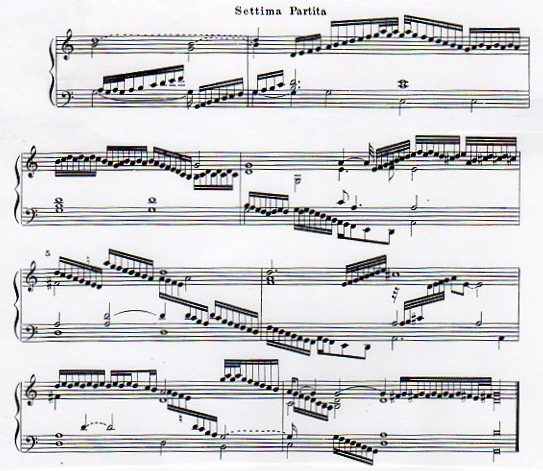
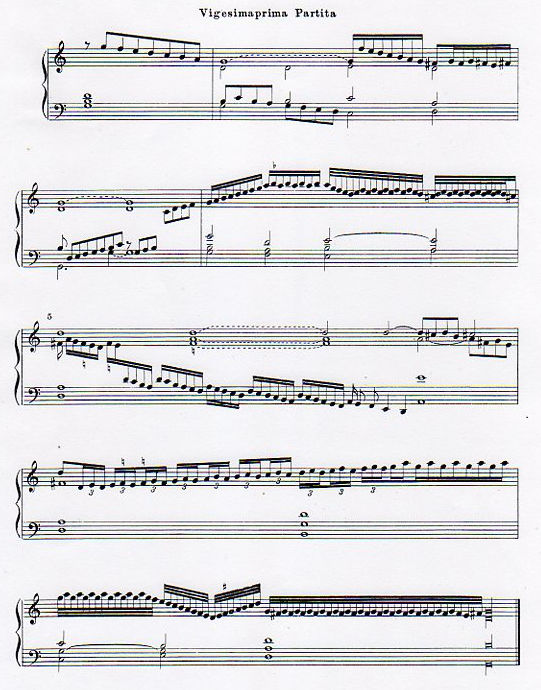
13.43 The setting of the Ruggiero ascribed “d’h[ercole]” (Ercole Pasquini) in the Trent manuscript consists of six partite. In general, like Trabaci’s partite 1-5 the variations display increasing rhythmic motion and maintain a given pattern throughout a partita. In the second half of partita 4 a new pattern appears which serves as a bridge to partita 5, consisting of 16th note passaggi in the right hand against block chords in the left, and partita 6, left hand passaggi against right-hand chords.
13.44 Frescobaldi’s treatment of the Ruggiero is cast in eight variations, in which the four phrases of the subject are always clearly audible under varying types of figuration. The clear statement of the bass allows variety within a single variation. For example, the 2.a parte employs four different (but related) figures, corresponding to the four phrases of the model. The terza parte, without passaggi, is marked by suspensions and syncopation. Brilliant scalar figuration appears only in variation seven, while the concluding vairation 8 echoes the suspensions of variations 1 and 3.
Ex. 13.14: Partite sopra Rvgiero (1615), settima parte

13.45 The Aria della Monaca was well known under various vocal and instrumental titles— “Une jeune fillette”and “Allemande nonette.” As well as serving as the melody for sacred and secular German texts, it was set for keyboard by William Byrde as “The Queenes Alman.”[17] The Italian text treats seriocomically a major social problem of early modern Italy: the plight of superfluous women:
Mother, don’t make me a nun because I don’t want to be one, / Don’t cut me a habit because I don’t want to wear it. / All day long in choir at vespers and at mass / And the mother abbess does nothing but scream, / She should drop dead.[18]
13.46 Marrying off a daughter of the middle and upper classes required a dowry commensurate with her family’s social standing, an expenditure without a compensating financial gain. Monacation was a considerably less expensive alternative with both good and bad aspects for the woman. On the one hand, it offered her a degree of independence from her family and even real power if she rose to high office in the cloister. On the other, it demanded (if it did not always receive) her absolute subjection under the vow of obedience to the women in authority over her and to the men in authority over them.[19] Female monasteries, like those of Ferrara, often cultivated superior musical performance and even composition but they were subject to the whims of male overseers, as witness the very different attitudes toward music of two cardinal archbishops of Milan, Carlo Borromeo and his cousin Federigo (see Kendrick 1996).
13.47 Frescobaldi’s first version of the Monaca consists of six statements of the tune, for the most part lightly varied in eighth-notes. The terza parte introduces some suspensions, while the quarta and quinta parti develop imitative intervallic countersubjects in the manner of Mayone’s Romanesca, with the quinta parte breaking into sixteenths.
Ex. 13.15: Monaca (1615)

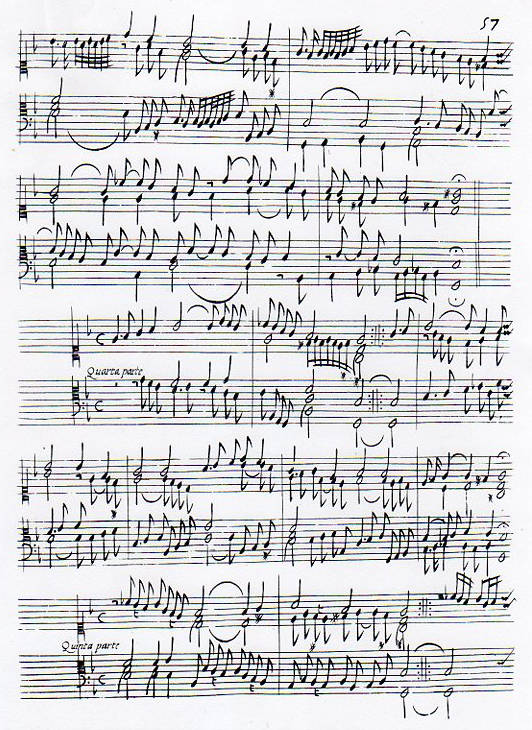
13.48 In the second edition of the Toccate e partite the toccatas were reprinted with only minor alterations of notation, some incorporating Frescobaldi’s suggestions in his prefaces. The variation-sets, however, were substantially reworked and a new one, the Folia, was added. Variations on the Fidele (Mayone) or Fedele (Trabaci) were published by Mayone (ten partite) and Trabaci (twenty partite) in their collections of 1603.[20] Both versions differ from the composers’ other variation sets. The meter is mainly triple (one partita in C in Mayone, four in Trabaci); the texture is largely homophonic; there are no passaggi and the decoration does not go beyond subdividing the basic beat. The basic material differs between the two composers, and neither version is identical with Frescobaldi’s Folia.
13.49 Mayone employs two bass lines in alternation, one skeletal and one figural:
Ex. 13.16: 1) Mayone, Fidele:

2) Mayone, Fidele:

13.50 Trabaci creates a two-phrase statement, the first ending on the fifth, D, and the second, which serves as a kind of ripresa, on the tonic G. Its rather loose relationship with Mayone’s formula consists mostly in their nodal points.
13.51 In his Folia Frescobaldi takes over from the Neapolitans this completely different type of variation. He organizes his variations into two sections, the first with repeat signs, and both ending on G. Repeat patterns may include AAB, AABB, and AAB[B]A.[21] Frescobaldi emphasizes the triple meter in his prima parte by notating it in breves and semibreves in ![]() 3/2, indicating a slower tempo. There are no passaggi, and hemiola ambiguities are exploited throughout. The quinta parte employs homophonic suspensions reminiscent of the partita decima of the Ruggiero and the final variation of the Romanesca (1616 versions).
3/2, indicating a slower tempo. There are no passaggi, and hemiola ambiguities are exploited throughout. The quinta parte employs homophonic suspensions reminiscent of the partita decima of the Ruggiero and the final variation of the Romanesca (1616 versions).
Ex. 13.17: Folia, Prima parte, Seconda parte
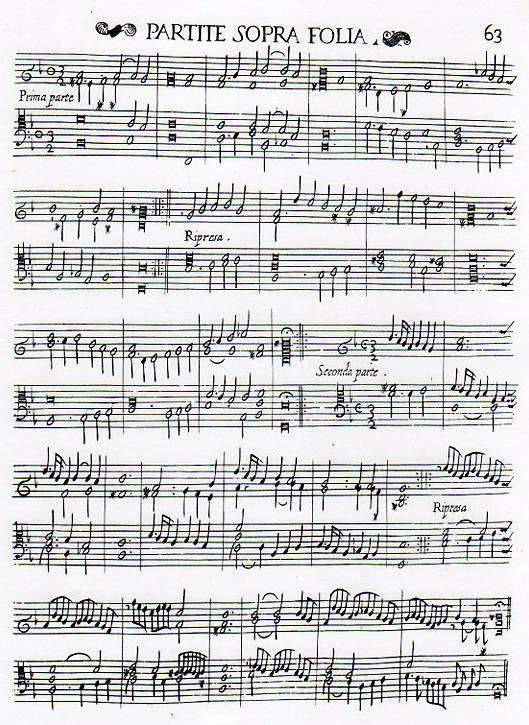
13.52 The emphasis in Frescobaldi’s prefaces on the sectional independence of both toccatas and variations raises the question of whether they were intended as cumulative entities or were conceived as merely additive structures. The revisions of the variations do not support a clear answer. In the Monica set, Frescobaldi re-wrote the original fifth variation, discarded the sixth, and added six new variations. It shows no greater overall cohesion in the second version than in the first, but a wider gamut of figuration and texture:
Ex. 13.18: Monica (1616), Decima parte, Vndecima parte

13.53 The same is largely true of the Ruggiero, where Frescobaldi wrote a new first variation, retained only the end of the original second one, simplified the ending of variation seven, replaced variation eight, and added four new variations. These changes are largely unrelated improvements, as in the replacement of the stodgy opening variation with a richer and livelier texture and the removal of the overly emphatic closing of the seventh variation, but the last three variations show some coherence in their movement from undecorated suspensions in thirds through an imitative texture to a concluding tripla, both also in thirds.[22]
Ex. 13.19: Ruggiero (1616), Vndecima parte, Duodecima parte
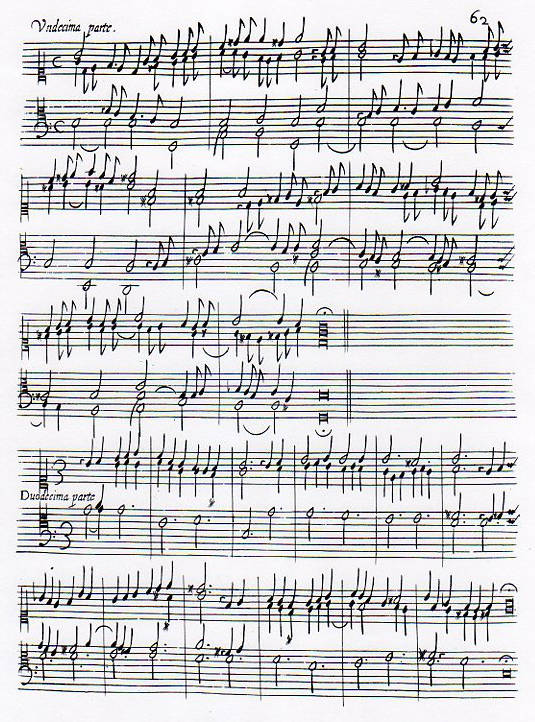
13.54 In recasting the Romanesca set, Frescobaldi went beyond localized improvements to clarify and sharpen the continuity, structure, and dramaturgy of the cycle, at the same time enriching the cross-references between the variations. He replaced the first four sections with new partite, added a triple variation in ![]() 3 (three quarters) as number five, repeated the original variations five through eleven as six through twelve, replaced the original twelfth variation, and added two more sections at the end.
3 (three quarters) as number five, repeated the original variations five through eleven as six through twelve, replaced the original twelfth variation, and added two more sections at the end.
13.55 A new coherence is evident from the first variation, where the pattern of thirds and suspensions only foreshadowed in the original dominates its replacement. The alternation of decorated and undecorated variations in the first version is dropped, and the eighth-note motion at the end of variation one flows uninterrupted into the beginning of variation two. The trill at the end of the new third variation similarly expands into the opening of the following section, the regular anapests of the original fourth variation are reserved for more telling use in the new variation XIII, and the interpolated triple section acts as a punctuation between the first and second groups of variations.
13.56 The second group, variations VI and VII, moves from the tense re-entrant figuration of the first to the more regular and brilliant writing of the second. The two following variations, presumably to be taken at a somewhat faster basic tempo since both lack passaggi and the first is marked ¢ rather than C (Trabaci’s “battuta stretta”), present a contrast in rhythmic texture and melodic inflection. Both are homophonic, the first largely diatonic with a few suspensions, the second highly chromatic with suspensions and passages of affetti cantabili, a procedure that recalls Trabaci’s Fedele variations of 1603.
Ex. 13.20: Romanesca (1616), nona parte

13.57 The next three variations, X to XII in the new arrangement, mark the high point of the set in terms of virtuosity, culminating in the dazzling thirty-seconds of variation XII.
13.58 In place of the original last variation with its fragmented rhythmic surface, as his concluding sections Frescobaldi presents two variations without passaggi, the first in even anapests, the second in half-note suspensions. On paper this seems an anticlimax. In much music of this period, however, the point of greatest intensity is reached well before the end, which functions not as a climax but as a confirmation or a transition back to the original level. (Think of the typical Scarlatti sonata.) Here the regular rhythm of the thirteenth variation acts as a brake on the brilliance of the preceding sections. The concluding partita is not only a schematic reduction of its predecessor, but in its persistent use of thirds it also reestablishes a link with the opening variation. Finally, by the utter sparseness of the closing Frescobaldi seems to thrust on our attention the simplicity of the foundation on which he has erected this imposing edifice.
13.59 The second version of the Toccate e partite closes with four correnti, Frescobaldi’s first printed essays in the world of the dance. Each consists of two sections, the first concise and beginning with an upbeat and a descending fourth (except for the third corrente, which begins on a downbeat with an ascending fourth) and the second section more discursive rhythmically and metrically. Stembridge 2009, 185, cites extra bars added at the end of both halves of the Corrente prima in the Turn ms., suggesting that it may have been customary to add an extra beat where the text seems incomplete. If the writing of the correnti sometimes betrays its descent from the crude chordally accompanied melodies of earlier Italian keyboard dances, it also displays refinements like the slithering hemiola suspensions of the second corrente.
Ex. 13.21: Corrente II
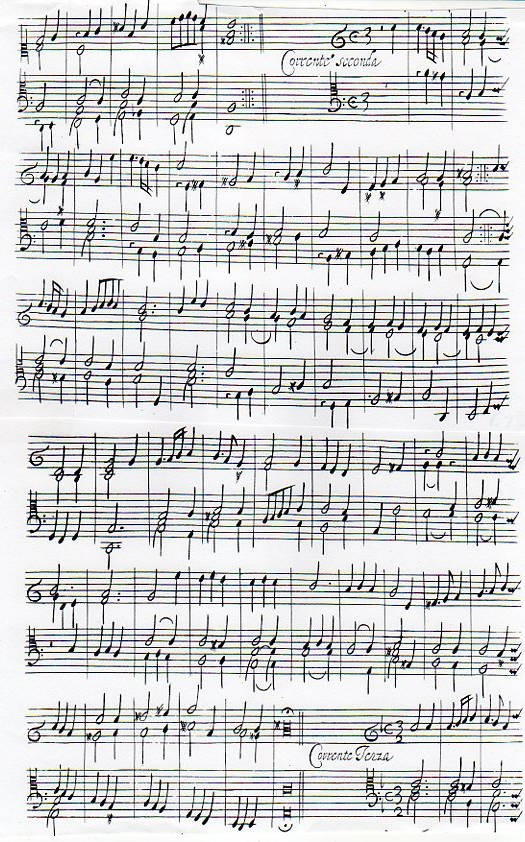
13.60 Frescobaldi never surpassed the finest achievements of the first volume of Toccate e partite. Decades later, Severo Bonini used the phrase “toccate e Romanesche di Frescobaldi” to epitomize the common currency of keyboard players. Even granting all that Girolamo may have owed his predecessors in Venice and Naples, as well as nearer home, the brilliance and control of his keyboard writing seem unprecedented. It is perhaps more accurate to suggest that the technical mastery of the Fantasie and Recercari provides the foundation for the Toccate, and that it is upon the noble structure and lucid articulation of his earlier contrapuntal works that Frescobaldi spreads the shining mosaic of his toccatas and variations.
FOOTNOTES

